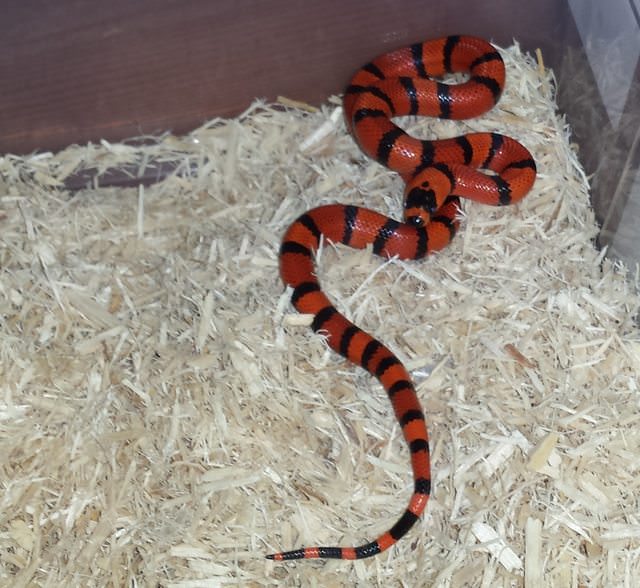
Nonvenomous milk snakes evolved to look like these venomous species in order to scare predators. They are often confused with copperheads and coral snakes because they all have bright, blotchy coloration. "Milk snakes are well known for their use of mimicry as a defensive strategy," Heyborne said. Like many nonvenomous snakes, milk snakes have round pupils, according to PA. Milk snakes are sexually alike, meaning that males and females grow to the same length and have the same coloration and patterns. Milk snakes have between 19 and 23 rows of scales, which are smooth.

Milk snakes in the United States and Canada don't grow beyond 51 inches (129 cm). The longest snakes are found in Central and South America. Milk snakes range from 14 to 69 inches (35.5 to 175 centimeters) long, according to ADW. Many milk snakes have a light-colored Y or V shape on their necks. The lighter area separating the colorful bands can be white, yellow or orange. "These bands can vary in color from white to red to black, and alternating bands of differing colors are common," he said. Albino lineage from Ben Seigel (USA).The appearance and coloration of milk snakes varies somewhat among the 24 subspecies, but all have banded coloration, said Heyborne. We are currently working with black & white specimens and also the albino variety. Primarily a rodent feeder, all Pines will readily consume avian prey when offered as well. Typically a burrowing species in the wild, providing hides and a few inches of loose substrate will keep your Pinesnake happy. Ensure that you are able to provide some degree of loose substrate (refrain from flat surfaces like using paper towels). While they may differ in the range of geography and colour, they all share their common love for sandy ground where they love to use their infamous rostral scale for digging. Their temperaments are typically mild-mannered but once in a while, you do find a moody individual that loves to show off the hissing prowess that the genus is famous for. Definitely a candidate for the larger terraria but do just fine being raised in a breeder-style rack system. With a contrasting black & white colour scheme, Northern Pinesnakes can reach lengths of 7′. Northern Pinesnakes fit that bill to a T. Pituophis melanoleucus melanoleucus – How could you go wrong with owning a Pinesnake? As long as their larger size can be accommodated, most Pinesnake species are easy and hardy captives that will quickly become a favorite in your collection. A more detailed article on this species will be found on our website soon (coming soon). We are currently working with a couple of genetic morphs as well. Husbandry parameters are not too complicated to achieve in captivity either. They are still a very rewarding species that exhibit prowess in their sight hunting skills. These animals grow very rapidly in their first couple of years and it’s no surprise to find yourself with a 5-6′ snake in a short time.


Hatchlings and juveniles may be raised in breeder style rack systems but adults will require a large cage. Being a large and active colubrid, caging of adequate size is paramount to their health.

A more terrestrial species that is always active and takes a variety of food items in captivity, from chicks, frogs & rodents. Typically imported as “king cobra food” by wholesalers in the past, this impressive species can reach lengths of over 10′. One of the few Colubrid species that have been listed on the CITES appendix (II) for many years and continue to be due to being harvested for their Cobra-like skin. Ptyas mucosa – A holy grail species for us that we are so proud to have been working with for the last 7 years and have been able to produce captive-bred animals for the hobby. Caution is to be used if you want to emulate this in captivity, as they would still require a large temperature gradient where they can still stay cool. Being a highland species, found in the cloud forests of Panama and Costa Rica, adult specimens have been found to be basking in pockets of sunlight and reaching temps of 90+F. A cooler temperature species, they do still benefit from a basking area in the 84-86F range. Starting out with the typical tricolor bands and gaining melanin (black pigment) progressively after their first year typically. Going through the ontogenic change from hatchlings to adults is equally as fun. With an impressive average size of 6′ in length, Black Milksnakes make great pets or terrarium displays. A hatchling can sometimes be squirmy but almost never musk or bite while being handled. Black Milksnakes almost always act more confident, especially as adults. Milksnakes typically have the reputation of being high strung and nervous animals. Lampropeltis triangulum gaigeae – Hands down our favorite milksnake in our collection.


 0 kommentar(er)
0 kommentar(er)
